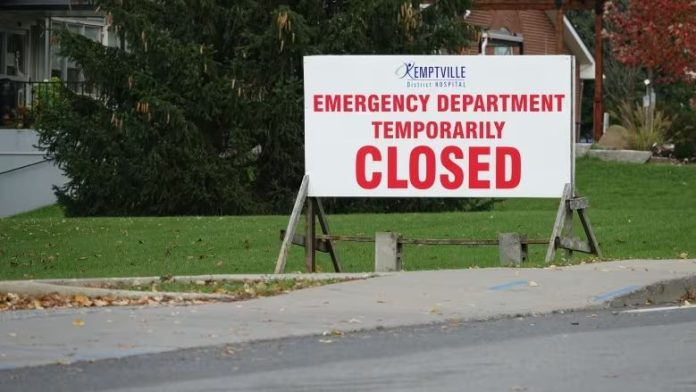
The Ontario Health Coalition (OHC) is demanding Premier Doug Ford take action to stop the growing number of emergency department closures across the province.
A new report title ‘Unprecedented and Worsening: Ontario’s Local Hospital Closures 2023’ released by the advocacy group this morning paints a “stark picture of a health care system that has tipped into collapse”.
“It is indisputable that these closures are endangering the health of Ontario residents,” OHC executive director Natalie Mehra said in a statement.
OHC says that while repeated closures in the last three years of vital hospital services (such as emergency departments, maternity and obstetrics, outpatient laboratories and intensive care) units “were unprecedented”, it found that “the number of emergency department closures has increased even more”.
The duration of closures is getting longer, according to OHC, with multiple towns across regions closing vital services at the same time.
The OHC report tracked a total of 1,199 closures of vital hospital services this year up until November 24 — 868 temporary or permanent emergency department closures (one is permanent); 316 urgent care centre closures; two outpatient laboratory closures; eleven obstetrics unit closures; one ICU closure, and; one labour and delivery unit closure (long-term).
“There is no excess hospital capacity to be closed,” Mehra stated. “Ontario has well-documented levels of hospital overcrowding and consequential emergency department backups that are extreme by all standards, national and international. The hospitals to which patients must drive — or to which they must somehow find transportation when their local hospital services are closed – are already overburdened and understaffed.”
“In the North, the distances between hospitals that are experiencing service closures are huge. Some hospitals have had services closed when they are an hour to four hours away from the next open service,” she added. “In the counties of Midwestern Ontario – Perth, Huron, Wellington, Dufferin, Bruce and Grey – we are seeing multiple hospital emergency departments closed at the same time with little to no notice. Patients in medical crises have to confirm on their own that the next hospital emergency isn’t also closed.”
OHC says the immediate cause of the closures is staff shortages including nurse, health professional and physician shortages. Mehra also blamed the worsening situation on an “unprecedented failure of leadership”.
“The failure of the provincial government to take responsibility for planning, recruiting and retaining needed health care staff, dealing with crises and setting standards for access to the most urgent of health care services is at odds with the approach of Ontario’s governments dating back at least forty years,” she says.
According to the OHC, Ontario has the fewest hospital beds per person left of any province in Canada and funds hospitals at the lowest rate in the country.
The advocacy group says hospital funding in Ontario is increasing by only 0.5% while health care inflation increased by 5.65%, a real-dollar cut, forcing hospitals to downsize their services and continuing downward pressure on wages for staff that are already in crisis-levels of short supply. At the same time, they have vastly increased funding for for-profit clinics and hospitals, and for for-profit staffing agencies.
“There can be no solution to the staffing crisis without retaining and attracting back staff into the regular workforce of our public hospitals. Instead, the provincial government is making public policy choices to impose budget austerity on public hospitals while funding private staffing agencies, not taking leadership, attempting to impose further wage suppression, and providing only short-term and belated emergency funding. The Health Coalition demanded the Ford government take real action to address the crisis.




